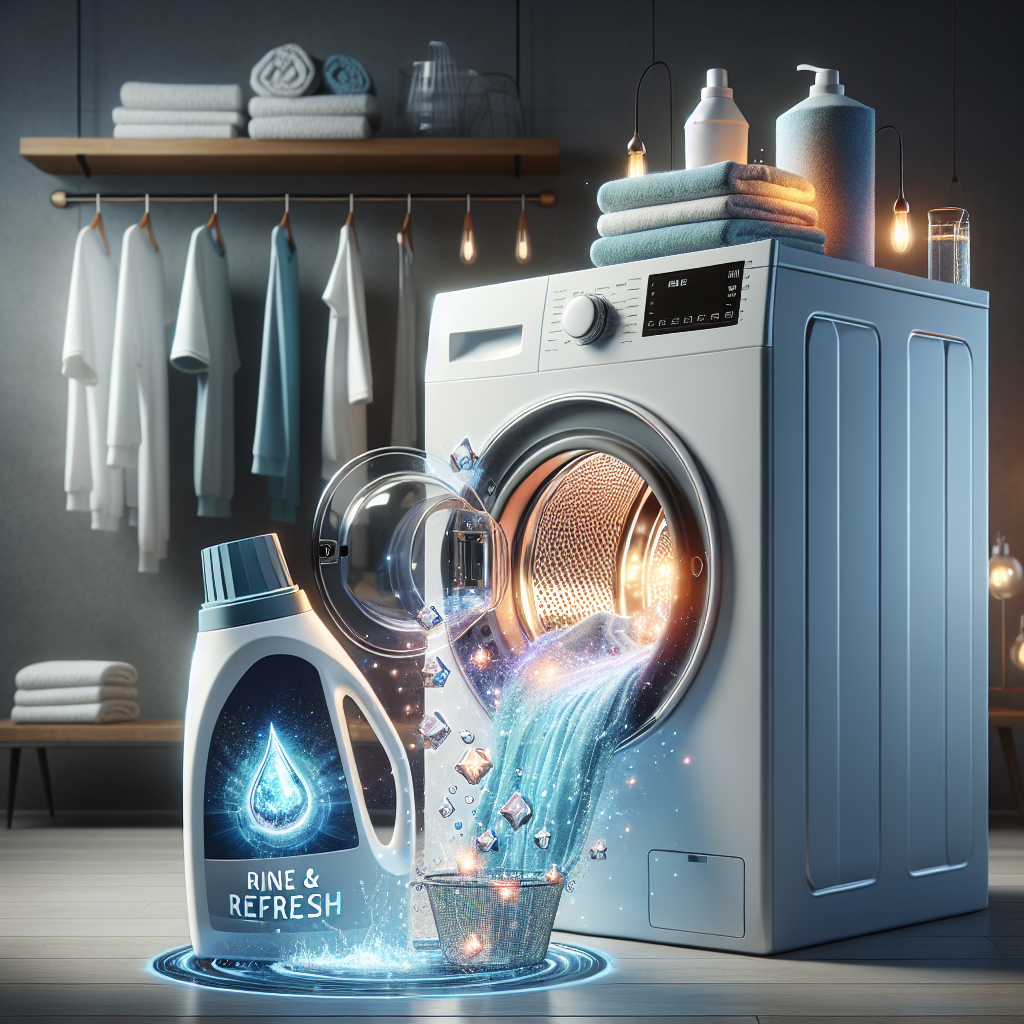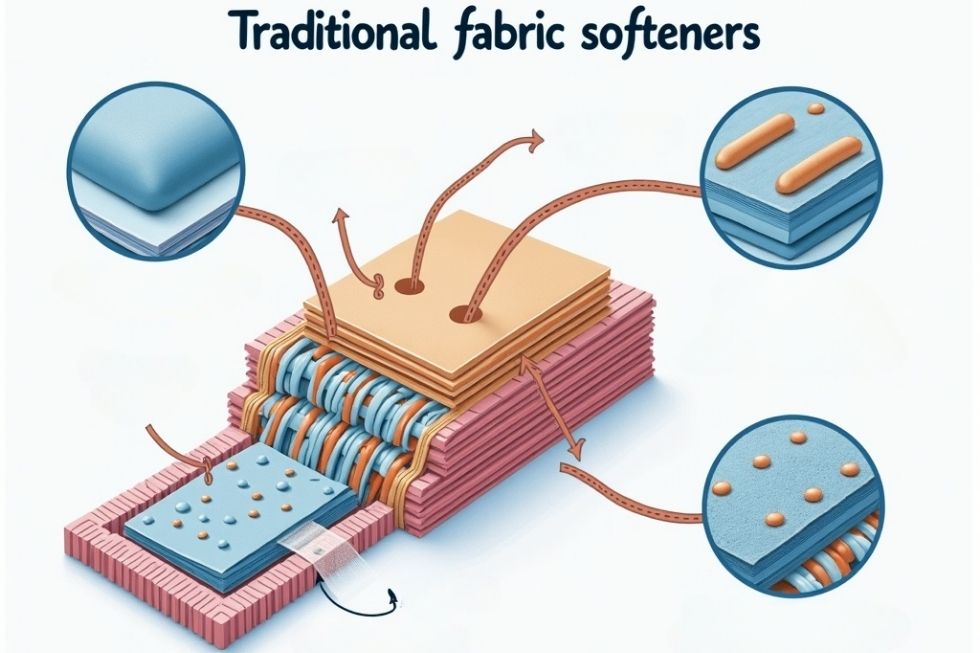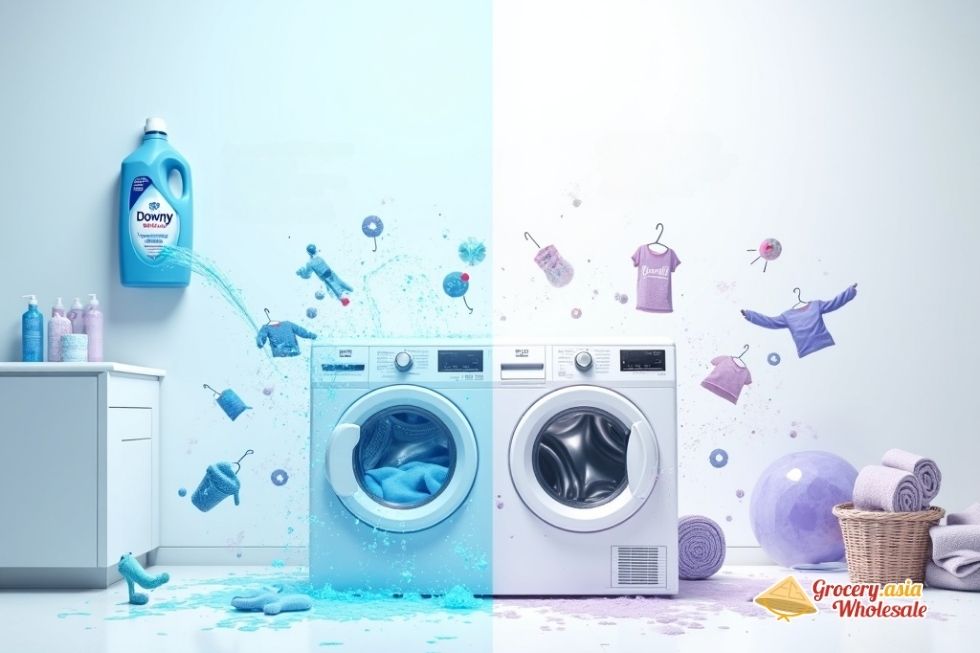No products in the cart.
Downy Fabric Softener, Fabric Conditioner, Home Care
Is Downy Rinse and Refresh a Fabric Softener or a Deep Clean Solution?
Is Downy Rinse and Refresh a fabric softener is a question many consumers ask, given its unique position in the laundry aisle. Unlike conventional fabric softeners, this product serves an entirely different purpose. It functions as a deep-cleansing fabric rinse that eliminates buildup and odors from clothes rather than adding softness. This clarifying treatment strips away accumulated residues from detergents, hard water minerals, and sweat that trap odor-causing bacteria in fabric fibers.
Table of Contents
Key Takeaways
- Downy Rinse & Refresh is a fabric clarifier that removes buildup and odors, not a traditional fabric softener that adds conditioning agents to fibers.
- The product uses citric acid with a low pH of approximately 3.5 to dissolve mineral deposits and alkaline residues that make fabrics stiff and smelly.
- It works particularly well on athletic wear, towels, and heavily soiled items by restoring absorbency and eliminating persistent odors without compromising fabric performance.
- Traditional fabric softeners coat fibers with cationic surfactants to create softness, while Rinse & Refresh removes existing coatings and buildup.
- Using both products simultaneously is counterproductive since they serve opposite functions – one removes buildup while the other adds coating.
Downy Rinse & Refresh: A Fabric Clarifier, Not a Softener
I need to clarify something important about Downy Rinse & Refresh: it’s not actually a fabric softener at all. This product functions as a deep-cleansing fabric rinse and odor remover that strips away buildup from your clothes rather than adding softness.
What Downy Rinse & Refresh Actually Does
The primary purpose of this product centers on removing stubborn odors and residues that your regular laundry detergent leaves behind. It operates during the rinse cycle to eliminate buildup from sweat, hard water minerals, and even excess detergent that can trap odor-causing bacteria in fabric fibers. Think of it as a clarifying shampoo for your clothes — it strips away accumulated residues instead of conditioning fabrics.
You’ll add Downy Rinse & Refresh to your fabric softener dispenser, but don’t let this placement fool you about its function. The product performs a clarifying action that leaves clothes cleaner and fresher by removing the very substances that make fabrics smell and feel dingy over time.
The Science Behind the Cleansing Power
The product’s marketed “3X Odor Power” refers specifically to its ability to help rinse away odor-causing residues that standard washing can miss. I’ve found that regular detergent sometimes can’t fully remove all the buildup, especially in athletic wear or clothes exposed to heavy perspiration. This residue becomes a breeding ground for bacteria that creates persistent odors.
Downy Rinse & Refresh works differently than traditional fabric softeners, which deposit conditioning agents onto fibers. Instead, it removes the barriers that prevent your clothes from getting truly clean. When you use this product, you’re essentially resetting your fabrics to a cleaner baseline.
If you’re looking for actual fabric softening properties, you’ll want to use a traditional product like Downy fabric conditioner separately or during a different wash cycle. The Rinse & Refresh formula focuses entirely on deep cleaning rather than adding softness or fragrance that lasts.
This clarifying approach makes it particularly useful for:
- Towels
- Athletic wear
- Any fabrics that have developed persistent odors despite regular washing
I recommend using it periodically rather than with every load to maintain optimal fabric cleanliness.

The Science Behind How It Works
Downy Rinse & Refresh operates on a fundamentally different principle than traditional fabric softeners. Instead of adding a lubricating layer to fabric fibers, this product removes accumulated buildup through chemical dissolution.
The Low-pH Formula Advantage
The product’s effectiveness stems from its acidic formulation with a pH of approximately 3.5. This acidic environment creates the perfect conditions for breaking down alkaline residues that accumulate over time from detergents and body soils. This approach is particularly effective because most laundry detergents are alkaline, leaving behind mineral deposits and soap scum that make fabrics feel stiff and look dingy.
Citric acid serves as the primary active ingredient, functioning as a powerful chelating agent. This natural compound chemically binds to mineral ions like calcium and magnesium – the main culprits behind fabric stiffness and reduced absorbency. When citric acid encounters these mineral deposits, it forms soluble complexes that wash away during the rinse cycle.
How It Differs From Conventional Softeners
Traditional fabric softeners work by depositing quaternary ammonium compounds onto fabric surfaces, creating a slippery coating that reduces friction. While this makes fabrics feel softer initially, it can also reduce absorbency over time. Downy Rinse & Refresh takes the opposite approach by removing layers of buildup rather than adding them.
The surfactant-free formula prevents the product from creating foam or leaving its own residue behind. This design choice ensures that only unwanted buildup gets removed while leaving fabric fibers clean and uncoated. According to Procter & Gamble patent US20210819A1 on fabric care compositions with low pH, this removal process restores fabric’s original texture and absorbency.
Hard water particularly benefits from this acidic treatment. Mineral-rich water leaves calcium and magnesium deposits that accumulate wash after wash, making towels scratchy and clothes feel rough. The chelating action of citric acid specifically targets these mineral deposits, dissolving them completely rather than masking their effects. This is why Downy’s approach proves especially valuable in areas with hard water conditions.
Traditional Fabric Softeners: A Different Approach
Traditional fabric softeners operate through a fundamentally different mechanism compared to products like Downy Rinse and Refresh. I’ve observed that these conventional softeners work by depositing a layer of conditioning agents directly onto fabric fibers, creating a protective coating that changes the textile’s surface properties.
How Cationic Surfactants Create Softness
The primary active ingredients in traditional fabric softeners are positively-charged cationic surfactants, most commonly Quaternary Ammonium Compounds (quats). These compounds have a lubricating, waxy texture that distinguishes them from other fabric treatment chemicals. The science behind their effectiveness lies in their electrical charge properties.
The positively-charged surfactants are naturally attracted to and bond with negatively-charged fabric fibers. This attraction creates a strong molecular bond that ensures the conditioning agents remain attached through the wash cycle. Once bonded, the long, fatty tails of the quat molecules orient outwards from the fibers, creating a soft, smooth coating across the entire fabric surface.
This coating serves multiple purposes in fabric conditioning:
- Reduces friction between individual fibers
- Creates a smoother surface texture
- Forms a protective barrier against future wear
- Provides the characteristic soft feel associated with fabric softeners
A common cationic surfactant used in many formulations is Dipalmitoylethyl Hydroxyethylmonium Methosulfate, which exemplifies the complex chemistry involved in traditional fabric conditioning.
However, this coating mechanism comes with significant drawbacks that I’ve noticed affect certain fabric types. The same coating that creates softness actually decreases the absorbency of towels by filling the spaces between fibers where water would normally be absorbed. This explains why towels treated with traditional fabric softeners often feel less effective at drying.
Additionally, technical fabrics designed for moisture-wicking face particular challenges with traditional softeners. These products can clog the microscopic pores that allow moisture-wicking fabrics to transport sweat away from the body. Athletes and fitness enthusiasts often discover that their fabric conditioner choices directly impact their gear’s performance.
The waxy buildup from repeated use of traditional softeners can accumulate over time, leading to fabrics that feel heavy or less breathable. This accumulation explains why some manufacturers recommend periodic washing without fabric softener to restore fabric performance.
Modern fabric care has evolved beyond this coating approach, with brands like Downy developing innovative solutions that address these traditional limitations. Understanding these differences helps consumers make informed decisions about which products best suit their specific fabric care needs and household requirements.
The chemistry of traditional fabric softeners remains effective for many applications, particularly with cotton and synthetic blends used in everyday clothing. However, recognizing their limitations allows for more strategic use in modern laundry routines.

Key Differences: Softener vs. Rinse & Refresh
Understanding the fundamental differences between traditional fabric softeners and Downy Rinse & Refresh reveals why these products serve distinct purposes in your laundry routine. I find that many people mistakenly believe they perform identical functions, but their mechanisms and effects couldn’t be more different.
Traditional fabric softeners work by coating individual fibers with a layer of lubricating chemicals. This coating process uses cationic surfactants, commonly called “quats,” as their primary active ingredients. These positively charged molecules bond to negatively charged fabric fibers, creating that familiar soft, slippery feel we associate with freshly laundered clothes. However, this coating also builds up over time, creating a waxy residue that can actually harm your fabrics’ performance.
Downy Rinse & Refresh takes an entirely different approach. Instead of adding layers to your fabrics, it clarifies fibers by removing existing buildup and residue. Its active ingredient is citric acid, formulated at a low pH level that effectively breaks down the accumulated deposits that trap odors. This clarifying action eliminates stubborn smells rather than simply masking them.
Impact on Fabric Performance
The coating effect of traditional softeners creates significant problems for specific fabric types. Towels lose their absorbency over time because the waxy buildup prevents fibers from effectively absorbing moisture. I’ve noticed that towels treated with regular softener often feel slippery and struggle to dry skin properly.
Athletic wear faces even more serious issues with conventional fabric softeners. These products clog the microscopic pores in technical fabrics, destroying their moisture-wicking capabilities. The coating interferes with the fabric’s ability to move sweat away from your body, making your workout gear less effective and potentially uncomfortable.
Rinse & Refresh addresses these concerns by actually removing the problematic buildup that causes performance issues. It helps restore towel absorbency by eliminating the waxy residue that traditional softeners leave behind. For athletic wear, this product safely removes embedded sweat odors without damaging the technical properties that make performance fabrics effective.
The tactile difference between these products is equally important. Fabric softeners create a distinctively soft, almost slick finish that many people expect from treated fabrics. This artificial smoothness comes from the chemical coating rather than the fabric’s natural properties. Rinse & Refresh leaves fabrics feeling clean and naturally soft, allowing you to experience your clothes’ true texture without artificial enhancement or buildup.
Ideal Uses for Rinse & Refresh
I’ve discovered that Rinse & Refresh excels in situations where traditional fabric softeners fall short. This unique product targets odor elimination as its primary function, making it perfect for specific laundry challenges that standard softeners can’t handle effectively.
Best Applications for Different Fabric Types
Athletic wear and workout clothes benefit tremendously from this product. I recommend using Rinse & Refresh on synthetic fabrics like polyester and spandex blends, where it removes stubborn sweat odors without compromising the moisture-wicking properties that make these materials so valuable for exercise. Gym clothes that still smell after regular washing get a fresh start when treated with this specialized formula.
Towels plagued by musty, mildewy odors transform after treatment with Rinse & Refresh. I’ve found it particularly effective at restoring absorbency to towels that have become stiff and less functional due to fabric softener buildup or hard water mineral deposits.
For families with active children, this product works wonders on heavily soiled sports uniforms. It deep cleans while eliminating the persistent odors that regular detergent often leaves behind. Pet owners will appreciate how effectively it removes tough animal odors from bedding and other fabric items.
Hard water creates its own set of laundry problems, causing stiffness and dinginess in fabrics. Rinse & Refresh combats these issues by addressing the mineral deposits that accumulate over time, helping restore fabrics to their original softness and appearance.
The product comes in several scent options including:
- Cool Cotton
- Fresh Lavender
- Ocean Mist
Those with sensitive skin can choose the Free & Gentle variety, which provides the same odor-fighting benefits without added fragrances.
What sets this product apart from traditional fabric softeners is its ability to strip away residue that harbors bacteria. This makes it particularly valuable for items that have developed persistent odors despite regular washing. Unlike conventional softeners that coat fibers, Rinse & Refresh penetrates deep to eliminate the source of odors while maintaining fabric performance.

Using Both Products: Possible but Counterproductive
I can confirm that using both Downy Rinse & Refresh and a fabric softener in the same wash load is technically feasible according to the manufacturer. The two products enter your washing machine at different stages of the cycle and don’t mix together in the drum, which means they won’t create any immediate chemical reactions or damage your clothes.
However, this approach works against itself from a functional standpoint. The fundamental purposes of these products directly contradict each other. Rinse & Refresh specifically targets and removes the buildup that accumulates on fabric fibers over time, including residue from previous fabric softener applications. Meanwhile, fabric softeners work by depositing conditioning agents onto fabric surfaces to create that soft, smooth feel you’re familiar with.
Strategic Product Selection
I recommend choosing one product per laundry load based on your specific goals for that particular wash. This targeted approach delivers better results than trying to use both simultaneously. Consider these practical applications:
- Use Rinse & Refresh for heavily soiled items like towels, workout clothes, and children’s play clothes that need deep cleaning
- Apply fabric conditioner to items where softness takes priority, such as bedding, sweaters, and delicate garments
- Choose Rinse & Refresh for loads with noticeable odors or stiffness that indicate buildup problems
- Select fabric softener for everyday clothing when you want enhanced comfort and fragrance
Another effective strategy involves using Rinse & Refresh as a periodic reset treatment. I suggest incorporating it into your routine once every few washes to strip away accumulated residue from detergents, fabric softeners, and hard water minerals. After this deep-cleaning cycle, you can return to using your preferred fabric softener as needed.
This cycling approach proves particularly beneficial if you live in an area with hard water or frequently use heavy-duty detergents. The mineral deposits and product buildup can make fabrics feel stiff and appear dull over time. Safe fabric softener ingredients work best on clean fibers, so the periodic use of Rinse & Refresh actually enhances the performance of your regular fabric softener.
Your washing frequency and water quality should influence how often you alternate between products. Households that do laundry daily might benefit from using Rinse & Refresh weekly, while those who wash less frequently might only need it monthly. Pay attention to how your clothes feel and smell – these indicators will guide your product selection better than any rigid schedule.
The key lies in understanding that these products serve different purposes in fabric care. Rinse & Refresh acts as a clarifying treatment that resets your fabrics to a clean baseline, while fabric softeners provide ongoing comfort and fragrance enhancement. Downy’s legacy products have been developed to work most effectively when used as intended rather than combined with competing formulations.
Rather than viewing this as a limitation, consider it an opportunity to customize your laundry care based on each load’s specific needs. Athletic wear responds better to the clarifying action of Rinse & Refresh, while your favorite cotton sheets will feel luxurious with traditional fabric softener treatment. This selective approach not only improves results but also makes your products last longer since you’re using them more efficiently.
Sources:
Procter & Gamble: Official Downy Website Product Information and FAQ pages
Good Housekeeping: “What Is a Laundry Rinse—and Does It Actually Work?”
Reviewed (USA Today): “Is Downy Rinse & Refresh worth it?”
CNET: “Stop Using Fabric Softener on Your Towels. Here’s Why”
United States Patent and Trademark Office: Patent US20210214819A1, “Fabric care compositions having a low pH” filed by The Procter & Gamble Company


